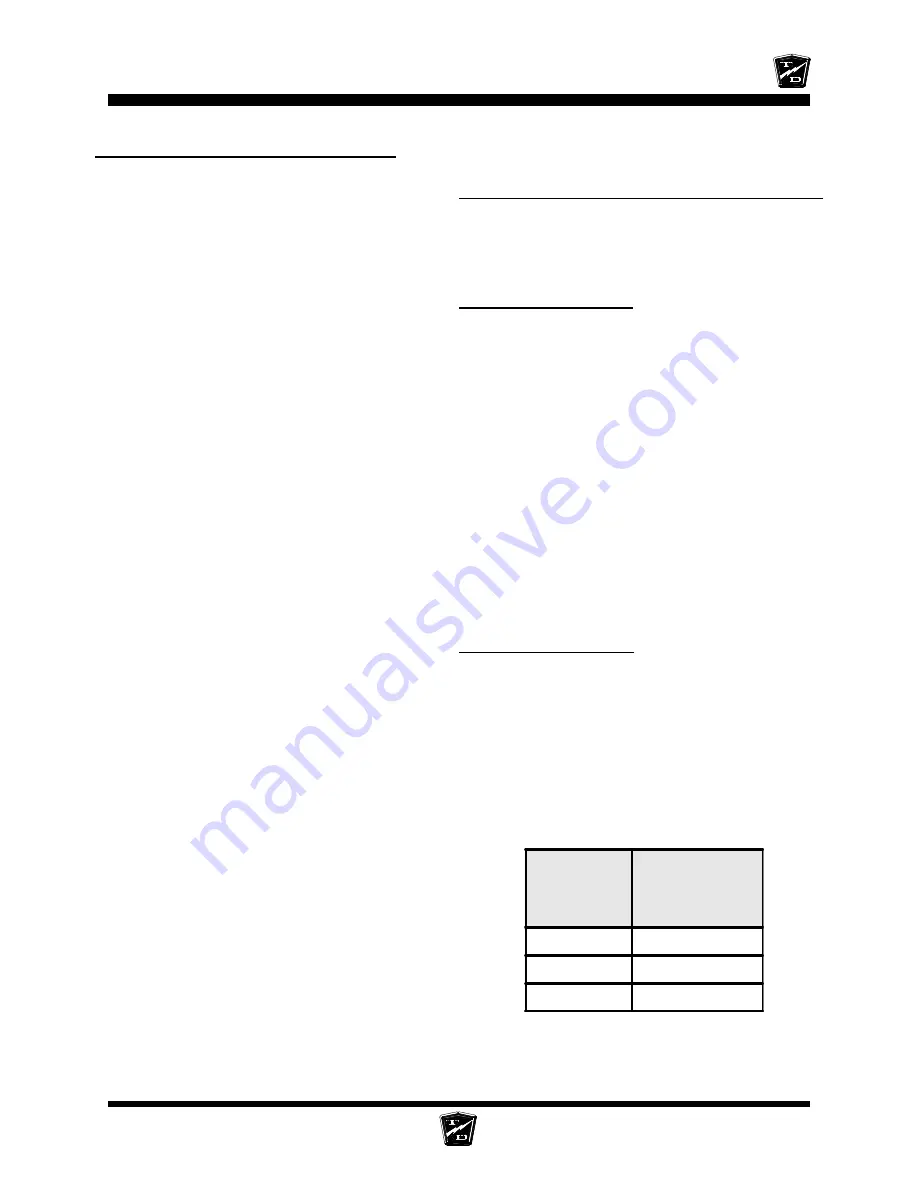
Safety Rules
Page 15
SAFETY RULES AND OPERATING INSTRUCTIONS
STORING / RETURNING TO
SERVICE
Both storing your vehicle and returning it to service
should only be performed by authorized personnel.
Storing Your Vehicle
•
Clean the batteries, then fill and charge before
putting the vehicle in storage. Do not store
batteries in a discharged condition.
•
Lube all grease fittings.
•
Clean, dry, and check all exposed electrical
connections.
•
Inflate tires to proper pressure (if applicable).
•
For extended storage, the vehicle should be
elevated so that the tires do not touch the
ground.
If stored for a prolonged period, the batteries should
be charged as follows:
Returning to Service
•
Check the battery’s state of charge and charge
if required.
•
Perform ALL maintenance checks in the
periodic checklist.
•
Remove any blocks from the vehicle and/or
place the vehicle down on to the ground.
•
Test drive before putting into normal service.
Storage
Temperature
(F)
Charging Interval
(months)
Over 60
1
Between 40 and 60
2
Below 40
6
To obtain the maximum battery life:
Charge the batteries only after they reach a
normal discharge as indicated on the Battery
Status Indicator (BSI). Failure to follow this
guideline could result in the batteries entering an
overcharge state, which will reduce the life of the
batteries. If you find it necessary to charge the
batteries before they are completely discharged
we recommend waiting until they are discharged
a minimum of 25% to reduce the possibility of
overcharging. Refer to Vehicle Controls in this
section for information on how to read the BSI.
Do not discharge the batteries beyond a normal
discharge as indicated on the BSI. Refer to
Vehicle Controls in this section for information on
how to read the BSI.
Check the battery electrolyte once a week. Do
not charge the batteries if the battery electrolyte
is low. Charging when the electrolyte is low will
damage the batteries and shorten their life-span.
Only authorized personnel should perform battery
maintenance including maintaining the battery
electrolyte level. Refer to Section
Maintenance,
Service and Repair
for battery maintenance
information.
Do not interrupt the charging cycle. When the
charger is plugged in, allow it to turn off before
disconnecting. Interrupting the charging cycle
could lead to overcharging or discharging the
batteries too deep. Both circumstances will
shorten the life of the batteries.
Summary of Contents for B 50
Page 2: ......
Page 6: ...TAYLOR DUNN...
Page 36: ...TAYLOR DUNN...
Page 65: ...Maintenance Service and Repair Steering Page 17 Steering Gear Exploded...
Page 66: ...TAYLOR DUNN...
Page 74: ...TAYLOR DUNN...
Page 82: ...TAYLOR DUNN...
Page 106: ...TAYLOR DUNN...
Page 118: ...TAYLOR DUNN...
Page 178: ...Illustrated Parts Parts Page 2 Front Axle and Suspension...
Page 180: ...Illustrated Parts Parts Page 4 Steering Linkage...
Page 182: ...Illustrated Parts Parts Page 6 Steering Gear...
Page 186: ...Illustrated Parts Parts Page 10 Rear Axle and Brakes...
Page 188: ...Illustrated Parts Parts Page 12 Rear Suspension...
Page 190: ...Illustrated Parts Parts Page 14 Motor 2 3 5 6 4 7 8 1 9 10 Armature 12...
Page 192: ...Illustrated Parts Parts Page 16 Brake linkage...
Page 194: ...Illustrated Parts Parts Page 18 Wheels and Tires Ref wheel hub 1 2 5 assembly 4 3 6 7 8 9 10...
Page 196: ...Illustrated Parts Parts Page 20 Instrument Panel Console...
Page 202: ...Illustrated Parts Parts Page 26 Miscellaneous Frame and Body...
Page 212: ...Illustrated Parts Parts Page 36 Decals...
Page 214: ...Illustrated Parts Parts Page 38 Sun Top and Windshield...
Page 216: ...Illustrated Parts Parts Page 40 Mirrors Multi Panel mirror Side mirror 9 11 2 1 2 5 4 6 7 3...
Page 218: ...Illustrated Parts Parts Page 42 Tool Box Luggage Rack 2 1 3 Tool box Luggage rack...
Page 220: ...Illustrated Parts Parts Page 44...
Page 221: ...TAYLOR DUNN...
Page 222: ...APPENDIX A Special Tools...
Page 229: ...TAYLOR DUNN...
Page 230: ...Appendix C...
Page 232: ......
















































